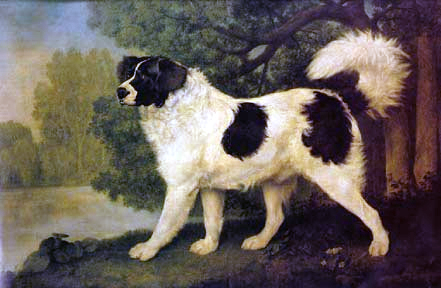 Portrait of a Newfoundland Dog
Portrait of a Newfoundland Dog (1803)
by
George Stubbs
Stubbs (1724 - 1806) was one of the preeminent British animal painters prior to Landseer. (Indeed, Landseer greatly admired Stubbs' work, and owned several pieces by him.)
The full title of this painting is Portrait of a Newfoundland Dog, the property of His R. H. the Duke of York. This work, exhibited at the Royal Academy in 1803 (the year after Edwin Landseer's birth), met with high praise, and it remains highly regarded today:
"When the portrait was painted, there were few Newfoundlands in Britain; and we know from a cursory list of Stubbs's work cited in his obituary notice that the painting was considered 'exceedingly fine, and of course a favourite picture.' The popularity of the canvas probably had as much to do with the subject as it did with the painting, for both Frederick, Duke of York (1763-1827) and his wife Princess Frederica Charlotte (1767-1820) were rather more fond of dogs than pictures." (Hugh Belsey, "A Newfoundland Dog by George Stubbs," Burlington Magazine 129 (Nov. 1987): 736).
This work is nearly life-size, measuring almost 7' x 4½'.
Belsey goes on to suggest (quite correctly, I believe) that this dog, which may have been named Nelson, is also portrayed in Peter Edward Stroehling's Frederica, Duchess of York, also treated here at The Cultured Newf.
An article about dog art auctions in the New York Times of February 17, 2000, noted that this painting (not part of the auction being discussed) had sold in November of 1999 for over $3.5 million, a record price at the time for a dog picture.
The June, 1803, issue of Sporting Magazine carried a list of "Sporting Subjects" that were exhibited at the Royal Academy that year, and included on the list is "Portrait of a Newfoundland Dog, the property of his Royal Highness the Duke of York. — G. Stubbs, RA." (120)
Stubbs also painted another, earlier work featuring what I believe is a Newfoundland, Portrait of a Dark Brown and White Newfoundland Spaniel (1788), which is also discussed here at The Cultured Newf.

